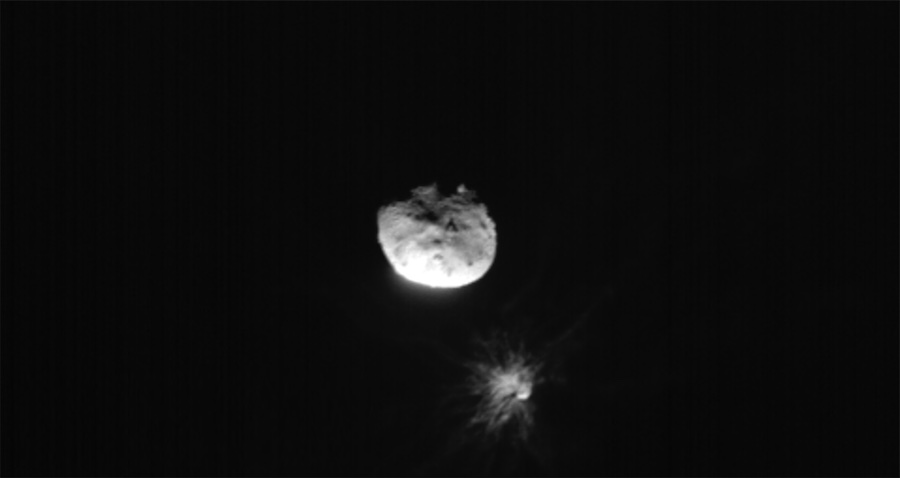STORY WRITTEN FOR CBS NEWS & USED WITH PERMISSION

The deliberate 14,000-mph crash of a small NASA probe into the asteroid Dimorphos two weeks ago nudged the 525-foot-wide body onto a slightly different course, NASA confirmed Tuesday, shaving 32 minutes off the time needed to complete one orbit around a parent asteroid known as Didymos.
The successful targeting, impact and now-confirmed course change demonstrated in spectacular fashion the viability of at least one technique for pushing a threatening asteroid or comet off course before it might slam into Earth with potentially devastating results.
“It felt like a movie plot. But this was not Hollywood,” said NASA Administrator Bill Nelson. “NASA successfully crashed a refrigerator-sized spacecraft into the asteroid Dimorphos, seven million miles from Earth. And it came in at 14,000 miles an hour. And it was a bullseye.”
The high-speed impact on September 26 blasted out a huge cloud of rock and dust clearly visible to ground- and space-based telescopes, an “ejecta” plume that contributed to the slight change in the asteroid’s orbit around Didymos.
Nelson said the Double Asteroid Redirection Test, or DART, test showed that if “an Earth-threatening asteroid was discovered, and we could see it far enough away, this technique could be used to deflect it.”
“And so today, NASA confirms that DART successfully changed the targeted asteroid’s trajectory,” he said.
The double-asteroid system offered an ideal target for the $330-million DART mission because the effects of the probe’s impact could be measured from Earth by precisely timing how the moonlet’s orbital period around Didymos changed as a result of the collision. Neither asteroid poses any threat to Earth.
For the past two weeks, optical telescopes on Earth and in space, along with two radar observatories, have been monitoring the asteroid pair on a near hourly bases, carefully tracking Dimorphos.

Credits: ASI/NASA
Before the impact, scientists estimated DART might shorten the moonlet’s orbital period by about 10 minutes. As it turned out, the energy imparted by the spacecraft and the recoil of debris blasted out into space shaved 32 minutes off the orbital period, changing it from 11 hours and 55 minutes to 11 hours and 23 minutes.
“For the first time ever, humanity has changed the orbit of a planetary body. First time ever,” said Lori Glaze, director of planetary science at NASA Headquarters. “The DART mission has demonstrated that we are capable of deflecting an asteroid, even a potentially hazardous asteroid, of this size using a kinetic impactor technique.”
But timing is everything, she said. The farther out a threatening body is detected, and the farther from Earth it is when an impactor reaches it, the less force is required to nudge it off course.
“To put this into perspective … this is a 4 percent change in the orbital period of Dimorphos around Didymos, and it just gave it a small nudge,” said Nancy Chabot, DART science coordinator at Johns Hopkins Applied Physics Laboratory in Laurel, Maryland.
“But if you wanted to do this in the future, it could potentially work, but you’d want to do it years in advance. Warning time is really key here in order to enable this sort of asteroid deflection to potentially be used in the future as part of a much larger planetary defense strategy.”
While the impact is behind them, the DART team is still hard at work, studying the still-visible ejecta plume to learn more about the structure of Dimorphos, whether the impact imparted a wobble, to pin down the density and possibly the mass of the asteroid and to refine models of how such bodies respond to impacts.
“All of this information plays into our understanding of what really happened in the experiment,” said Tom Statler, DART program scientist at NASA Headquarters. “How effectively did the kinetic impact change the motion of the asteroid? How efficiently was momentum transferred?
“It’s too soon to say, there’s a lot of moving parts in this calculation. But it looks like the recoil from the ejecta blasted off the surface was a substantial contributor to the overall push given to the asteroid. … So there’s a lot yet to come.”
from Spaceflight Now https://ift.tt/vipxEcu
via World Space Info







0 comments:
Post a Comment